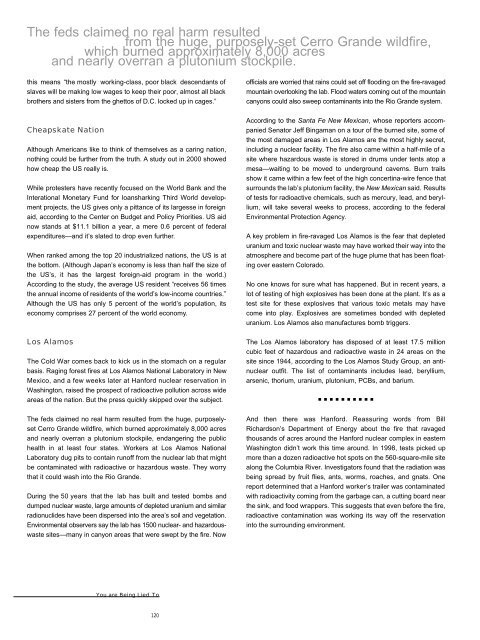otherwise
you are being lied to
you are being lied to
Create successful ePaper yourself
Turn your PDF publications into a flip-book with our unique Google optimized e-Paper software.
The feds claimed no real harm resulted<br />
from the huge, purposely-set Cerro Grande wildfire,<br />
which burned approximately 8,000 acres<br />
and nearly overran a plutonium stockpile.<br />
this means “the mostly working-class, poor black descendants of<br />
slaves will be making low wages to keep their poor, almost all black<br />
brothers and sisters from the ghettos of D.C. locked up in cages.”<br />
o fficials are worried that rains could set off flooding on the fire-ravaged<br />
mountain overlooking the lab. Flood waters coming out of the mountain<br />
canyons could also sweep contaminants into the Rio Grande system.<br />
Cheapskate Nation<br />
Although Americans like to think of themselves as a caring nation,<br />
nothing could be further from the truth. A study out in 2000 showed<br />
how cheap the US really is.<br />
While protesters have recently focused on the World Bank and the<br />
Interational Monetary Fund for loansharking Third World development<br />
projects, the US gives only a pittance of its largesse in foreign<br />
aid, according to the Center on Budget and Policy Priorities. US aid<br />
now stands at $11.1 billion a year, a mere 0.6 percent of federal<br />
expenditures—and it’s slated to drop even further.<br />
When ranked among the top 20 industrialized nations, the US is at<br />
the bottom. (Although Japan’s economy is less than half the size of<br />
the US’s, it has the largest foreign-aid program in the world.)<br />
According to the study, the average US resident “receives 56 times<br />
the annual income of residents of the world’s low-income countries.”<br />
Although the US has only 5 percent of the world’s population, its<br />
economy comprises 27 percent of the world economy.<br />
Los Alamos<br />
The Cold War comes back to kick us in the stomach on a regular<br />
basis. Raging forest fires at Los Alamos National Laboratory in New<br />
Mexico, and a few weeks later at Hanford nuclear reservation in<br />
Washington, raised the prospect of radioactive pollution across wide<br />
areas of the nation. But the press quickly skipped over the subject.<br />
The feds claimed no real harm resulted from the huge, purposelyset<br />
Cerro Grande wildfire, which burned approximately 8,000 acres<br />
and nearly overran a plutonium stockpile, endangering the public<br />
health in at least four states. Workers at Los Alamos National<br />
Laboratory dug pits to contain runoff from the nuclear lab that might<br />
be contaminated with radioactive or hazardous waste. They worry<br />
that it could wash into the Rio Grande.<br />
During the 50 years that the lab has built and tested bombs and<br />
dumped nuclear waste, large amounts of depleted uranium and similar<br />
radionuclides have been dispersed into the area’s soil and vegetation.<br />
Environmental observers say the lab has 1500 nuclear- and hazardouswaste<br />
sites—many in canyon areas that were swept by the fire. Now<br />
According to the Santa Fe New Mexican, whose reporters accompanied<br />
Senator Jeff Bingaman on a tour of the burned site, some of<br />
the most damaged areas in Los Alamos are the most highly secret,<br />
including a nuclear facility. The fire also came within a half-mile of a<br />
site where hazardous waste is stored in drums under tents atop a<br />
mesa—waiting to be moved to underground caverns. Burn trails<br />
show it came within a few feet of the high concertina-wire fence that<br />
surrounds the lab’s plutonium facility, the New Mexican said. Results<br />
of tests for radioactive chemicals, such as mercury, lead, and beryllium,<br />
will take several weeks to process, according to the federal<br />
Environmental Protection Agency.<br />
A key problem in fire-ravaged Los Alamos is the fear that depleted<br />
uranium and toxic nuclear waste may have worked their way into the<br />
atmosphere and become part of the huge plume that has been floating<br />
over eastern Colorado.<br />
No one knows for sure what has happened. But in recent years, a<br />
lot of testing of high explosives has been done at the plant. It’s as a<br />
test site for these explosives that various toxic metals may have<br />
come into play. Explosives are sometimes bonded with depleted<br />
uranium. Los Alamos also manufactures bomb triggers.<br />
The Los Alamos laboratory has disposed of at least 17.5 million<br />
cubic feet of hazardous and radioactive waste in 24 areas on the<br />
site since 1944, according to the Los Alamos Study Group, an antinuclear<br />
outfit. The list of contaminants includes lead, beryllium,<br />
arsenic, thorium, uranium, plutonium, PCBs, and barium.<br />
<br />
And then there was Hanford. Reassuring words from Bill<br />
Richardson’s Department of Energy about the fire that ravaged<br />
thousands of acres around the Hanford nuclear complex in eastern<br />
Washington didn’t work this time around. In 1998, tests picked up<br />
more than a dozen radioactive hot spots on the 560-square-mile site<br />
along the Columbia River. Investigators found that the radiation was<br />
being spread by fruit flies, ants, worms, roaches, and gnats. One<br />
report determined that a Hanford worker’s trailer was contaminated<br />
with radioactivity coming from the garbage can, a cutting board near<br />
the sink, and food wrappers. This suggests that even before the fire,<br />
radioactive contamination was working its way off the reservation<br />
into the surrounding environment.<br />
You are Being Lied To<br />
120


